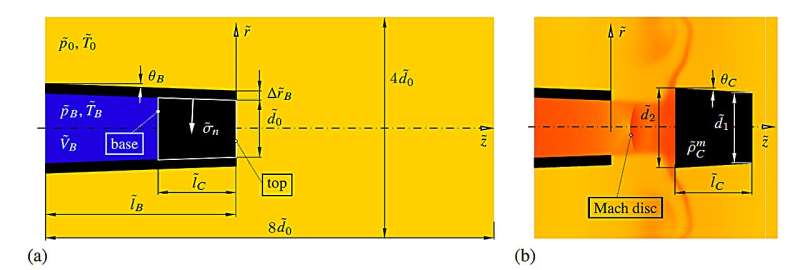This article has been reviewed according to Science X's editorial process and policies. Editors have highlighted the following attributes while ensuring the content's credibility:
fact-checked
preprint
trusted source
proofread
Clarified at last: The physics of popping champagne

When you uncork a bottle of champagne, complex supersonic phenomena occur. Scientists at TU Wien have now been able to calculate exactly what happens for the first time.
It sounds like a simple, well-known everyday phenomenon: there is high pressure in a champagne bottle, the stopper is driven outwards by the compressed gas in the bottle and flies away with a powerful pop. But the physics behind this is complicated.
Experiments with high-speed cameras have already been carried out, but a mathematical-numerical analysis has been lacking. This gap has now been closed at TU Wien. Using complex computer simulations, it was possible to recalculate the behavior of the stopper and the gas flow.
In the process, astonishing phenomena were discovered: a supersonic shock wave is formed and the gas flow can reach more than one and a half times the speed of sound. The results, which appear on the pre-print server arXiv, are also important for other applications involving gas flows around ballistic missiles, projectiles or rockets.
The shock wave from the bottle
"The champagne cork itself flies away at a comparatively low speed, reaching perhaps 20 meters per second," says Lukas Wagner, the first author of the study, who is a doctoral student at the Institute of Fluid Mechanics and Heat Transfer at TU Wien and also conducts research at the private Austrian Competence Center for Tribology (AC2T).
"However, the gas that flows out of the bottle is much faster," says Wagner. "It overtakes the cork, flows past it and reaches speeds of up to 400 meters per second."
That is faster than the speed of sound. The gas jet therefore breaks the sound barrier shortly after the bottle is opened—and this is accompanied by a shock wave. Normally, variables such as pressure and temperature in a gas change continuously: two points that are close to each other also have approximately the same air pressure. But when a shock wave occurs, things are different.
"Then there are jumps in these variables, so-called discontinuities," says Bernhard Scheichl (TU Vienna & AC2T), Lukas Wagner's dissertation supervisor. "Then the pressure or velocity in front of the shock wave have a completely different value than just behind it."
This point in the gas jet, where the pressure changes abruptly, is also known as the "Mach disk." "Very similar phenomena are also known from supersonic aircraft or rockets, where the exhaust jet exits the engines at high speed," explains Stefan Braun (TU Wien), who came up with the original idea for the project and supervised Mr. Wagner's master thesis on the subject. The Mach disk first forms between the bottle and the cork and then moves back towards the bottle opening.
Temporarily colder than the North Pole
Not only the gas pressure, but also the temperature changes abruptly: "When gas expands, it becomes cooler, as we know from spray cans," explains Lukas Wagner. This effect is very pronounced in the champagne bottle: the gas can cool down to -130°C at certain points. It can even happen that tiny dry ice crystals are formed from the CO2 that makes the sparkling wine bubble.
"This effect depends on the original temperature of the sparkling wine," says Lukas Wagner. "Different temperatures lead to dry ice crystals of different sizes, which then scatter light in different ways. This results in variously colored smoke. In principle, you can measure the temperature of the sparkling wine by just looking at the color of the smoke."
Cork expansion and shock wave popping
"The fact that supersonic phenomena actually occur when a bottle of sparkling wine pops was anything but clear at first—you wouldn't necessarily expect it," says Bernhard Scheichl. "But our simulations show that this arises quite naturally from the equations of fluid mechanics, and our results agree very well with the experiments."
The audible pop when the bottle is opened is a combination of different effects: Firstly, the cork expands abruptly as soon as it has left the bottle, creating a pressure wave, and secondly, you can hear the shock wave, generated by the supersonic gas jet—very similar to the well-known aeroacoustic phenomenon of the sonic boom. Both together are responsible for the characteristic sound of the champagne cork popping. The expansion of the stopper was modeled based on the experiments conducted by Mr. Wagner at AC2T.
The methods that have now been developed to solve the puzzles surrounding the physics of champagne cork popping can also be applied to other related areas: From firing pistol bullets to launching rockets—in many technically important situations you are dealing with very solid flow bodies that interact strongly with a much faster gas flow.
More information: Lukas Wagner et al, Simulating the opening of a champagne bottle, arXiv (2023). DOI: 10.48550/arxiv.2312.12271
Journal information: arXiv
Provided by Vienna University of Technology





















